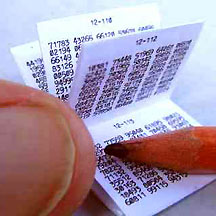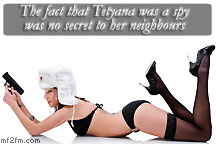Thursday 23 July, 2009, 08:00 - Radio Randomness
Posted by Administrator
It may come as a surprise to the more ICT literate that in this day and age, short-wave radio is still being used for secret communications from various security organisations to their field agents. No encrypted e-mails or messages hidden on web-pages, no images hidden in jpeg files or microdots or secret domain extensions. Nope, many agencies transmit messages over short-wave using standard AM modulation which can be received on every day, off-the-shelf radios.Posted by Administrator
You may have even heard these transmissions and not known what they were. Known as 'numbers stations', the transmissions consist of a series of numbers being read out in a mechanical fashion, often repeated several times and often preceded by a specific piece of music. The numbers are usually in English, German, Spanish, Arabic or a slavic language (eg Russian) which may give an indication of the source of the signals (though it is known, for example, that some of the transmissions in English are from the Israeli secret service, Mossad).
Unlike most short-wave transmissions, the source of these signals is often elusive and as such, receiving any kind of acknowledgement of their reception is nigh on impossible. This does not stop, though, a band of enthusiasts monitoring and recording these signals and exchanging information between likeminded individuals. Probably the largest such group is known as 'Enigma 2000' who publish a regular monthly newsletter which can, thankfully, be obtained for those who are interested without the need to join the group (which has strict membership criteria) from the Numbers and Oddities site.
A typical numbers transmission consists of the following elements:
* A piece of music or other 'tuning signal' to enable the transmissions to be easily identified
* A set of numbers or letters to identify which agent the message is addressed to
* A message identifier (so that the agent knows whether this is a new message or one already received)
* The encryption key (page in the one time pad - see below)
* The message itself
It might end up looking something like this:
131 1 445 137
40169 89117 20298 35013 41171 11312 63536 93396 46878 16093
29358 33200 82800 62186 11396 84614 82364 31802 82184 13856
76542 20793 72496 02687 56367 66812 18736 23959 33356 29647
21272 04668 08563 59079 71771 45056 59223 74346 70438 99776
45393 22483 06897 74008 87564 11186 28378 86003 16942 77970
000 000
 So how does the agent decode this message? It is suggested by those in the know, that they are unravelled using something called a 'one time pad'. The agent looks up the page in his book of one time pads which has a set of figures which allows the numbers to be translated into letters or words to decode the message. Once decoded, the page in the pad is burnt, eaten or otherwise destroyed. Without access to the pad, the message cannot be decrypted (eg by opposing security agencies) which makes it singularly secure. If the agent is captured and his pad falls into enemy hands, as long as the HQ is aware, they can stop sending messages to that agent. As each agent's pads are different, they cannot decode messages sent to other agents.
So how does the agent decode this message? It is suggested by those in the know, that they are unravelled using something called a 'one time pad'. The agent looks up the page in his book of one time pads which has a set of figures which allows the numbers to be translated into letters or words to decode the message. Once decoded, the page in the pad is burnt, eaten or otherwise destroyed. Without access to the pad, the message cannot be decrypted (eg by opposing security agencies) which makes it singularly secure. If the agent is captured and his pad falls into enemy hands, as long as the HQ is aware, they can stop sending messages to that agent. As each agent's pads are different, they cannot decode messages sent to other agents.That such messaging systems are still used is, perhaps, not that surprising. That they should still rely on short-wave radio to send these messages to agents perhaps is. An e-mail could do the same job much more quickly and for less money. The advantage, however, of short-wave is that no specialist equipment is required to get hold of the message (short-wave radios are available in markets and bazaars around the world for a handful of dollars) and has the real advantage that the location and identity of the agent are not revealed by the transmission as they might be if an e-mail was traced by the authorities.
 Hearing these transmissions is relatively easy. Mossad in particular seems to pepper the airwaves with transmissions, usually in the hours of darkness in Europe when local propagation is more straightforward (and presumably when agents are not out doing their day job!) Common frequencies include (though these change seasonally) 3840, 4270, 4880, 5435, 6840 and 9130 kHz from around 1800 GMT to at least 2000 GMT and later.
Hearing these transmissions is relatively easy. Mossad in particular seems to pepper the airwaves with transmissions, usually in the hours of darkness in Europe when local propagation is more straightforward (and presumably when agents are not out doing their day job!) Common frequencies include (though these change seasonally) 3840, 4270, 4880, 5435, 6840 and 9130 kHz from around 1800 GMT to at least 2000 GMT and later.So, if you catch your Ukranian neighbour sunning herself in the garden whilst listening to seemingly random sets of numbers being read out on the radio, thanks to Wireless Waffle you now know exactly what is going on!
1 comment
( 1660 views )
| permalink
| 



 ( 2.9 / 25965 )
( 2.9 / 25965 )




 ( 2.9 / 25965 )
( 2.9 / 25965 )

